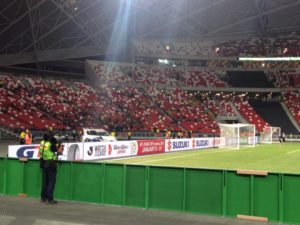- Column
2015/1/3 | Asia
J.League To Win Over Southeast Asian Fans
So the story goes, Gamba Osaka just emerged as the 2014 J.League Champions and one of their main sponsors is Panasonic, a huge Japanese conglomerate with a vast network base within Southeast Asia.
In Singapore, we just witnessed Japan vs Brazil at the National Stadium which saw thousands upon thousands of Singaporean fans wear the colours of Samurai Blue.
It is a well known fact, that in Asia, Japan has one of the best footballing leagues in the entire continent in terms of the technical ability of the players as well as financial backing from corporate sponsors, the J.League is widely regarded as Asia’s best domestic competition at least in terms of operation, administration and organisation, has been making inroads into Southeast Asia.
With the rise and emergence of Chinese brands, Japanese brands are fighting back to maintain market equity through a softer and more universal approach through the game that the Southeast Asians readily love and connect with, – Football.
For Japan, access to new markets to show games and offer opportunities for sponsors coupled with the possibility of access to young talent from the region is attractive, this is truly a strategic approach to penetrate these emerging markets and gain even more strength in markets that are already developed.
One such example is Vietnam’s very own Le Cong Vinh who was on loan to Japan division 2 side Consadole Sapporo, with his inclusion in a Japanese team, he acted almost as a bridge between two countries
“Many Japanese companies have been targeting South East Asia, and the J.League is trying to do the same,” said Kei Koyama of the league’s Asia Strategy Office. “We are trying to increase the fan base of the J.League while at the same time helping Asian soccer develop, which benefits everyone.”
The J.League insists it is committed to developing football in Southeast Asia for the long-term and at a number of levels, over the past two years, the J.League has signed separate partnership agreements with leagues in Thailand, Vietnam, Cambodia, Singapore and Myanmar which involve the exchange of expertise on and off the field.
“The reputation of the J.League is improving partly due to the increasing number of players from Japan heading to the top leagues of Europe. Their football players have made huge progress in domestic and international competitions. … Japan shows how a team can compete equally against physically stronger teams.”
There is without a doubt an increasing popularity of Japanese football outside Japan, the J.League initiated negotiations with authorities from the four Southeast Asian nations, felt that Japanese football fans in those countries would likely watch Japanese football if it was broadcast free of charge on terrestrial TV.
In pursuing the project, the J.League also intends to project itself as part of the “Cool Japan” culture, which generally refers to things such as manga and anime, to boost its profile in the region.
(Institute for Future Asian Football / Timothy Lim)
- Hot News
- Hot Column
 2014 Witnesses a Dramatic Change in the Rising Cambodian Football League with a Speedy Improvement in the Relationship with Japan
2014 Witnesses a Dramatic Change in the Rising Cambodian Football League with a Speedy Improvement in the Relationship with Japan  J.League To Win Over Southeast Asian Fans
J.League To Win Over Southeast Asian Fans  Japan’s opponent: The best amateur football club in the world
Japan’s opponent: The best amateur football club in the world ![[Special Interview] Takuya Iwata: Japanese footballer at Auckland City FC](http://en.ifaf.asia/wp-content/plugins/wordpress-popular-posts/public/images/no_thumb.jpg) [Special Interview] Takuya Iwata: Japanese footballer at Auckland City FC
[Special Interview] Takuya Iwata: Japanese footballer at Auckland City FC  Football Media Talk – Singapore and Japan – 2nd Half
Football Media Talk – Singapore and Japan – 2nd Half






